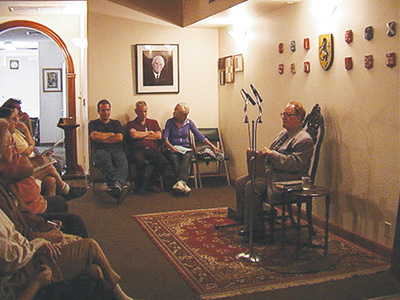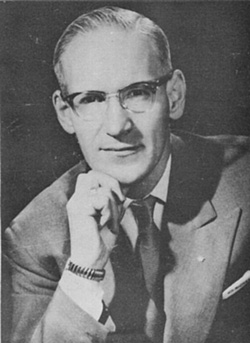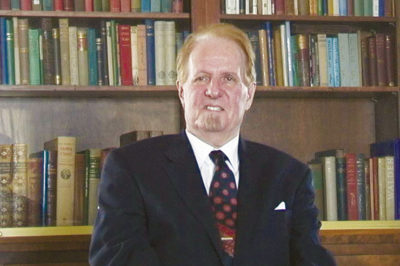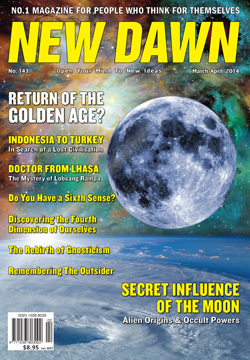From New Dawn 143 (Mar-Apr 2014)
One of the most compelling themes of current times is Gnosis – the idea of a transcendental knowledge that, like enlightenment, liberates the individual from bondage to the world of suffering. While Gnosis and Gnosticism were long relegated to the archives of memory as heretical and obsolete aspects of early Christianity, over the last few generations their ideas have resurfaced, displaying an unforeseen power and resonance.
Stephan A. Hoeller is among the leading proponents of this revitalised Gnosticism. Born a Hungarian nobleman in 1931, he was exiled from his native country after World War II. He came to the United States in the early 1950s and in the decades since has attracted a small but influential nucleus of students of esotericism. He has delivered scores of lectures to organisations such as the Theosophical Society and the Philosophical Research Society in a number of nations, including Australia and New Zealand.
Hoeller is the author of several books, including Gnosticism: New Light on the Ancient Tradition of Inner Knowing (2002); The Fool’s Pilgrimage: Kabbalistic Meditations on the Tarot (2004); Jung and the Lost Gospels: Insights into the Dead Sea Scrolls and the Nag Hammadi Library (1989); and The Gnostic Jung and the Seven Sermons to the Dead (1982). Among other accomplishments, Hoeller’s work ties the Gnostic stream to the ideas of the Swiss psychologist C.G. Jung.
Hoeller is also a major figure in the independent sacramental movement. This loose collection of churches and societies is based on the apostolic tradition as carried on by bishops, many of whom have left the Catholic Church or other Christian bodies and who have consecrated bishops and ordain priests on their own. Hoeller was ordained to the priesthood of the American Catholic Church by Bishop Lowell P. Wadle in 1958, and to the Gnostic episcopate by Richard, Duc de Palatine (born Ronald Powell) in 1967. Today Hoeller is presiding bishop of the Ecclesia Gnostica in Los Angeles. For more information on his work, including his lectures, visit his website www.gnosis.org.
This interview, conducted by e-mail in November 2013, focuses on Gnosticism and Hoeller’s connection to the Australian born ‘wandering bishop’ Richard, Duc de Palatine.
Richard Smoley (RS): You have been an eloquent spokesman for a revitalised Gnosticism in our time. Could you say briefly what the features of this Gnosticism are?
Stephan Hoeller (SH): Gnosticism is not a belief system in the accustomed sense, and therefore it is not easy to describe its features as you ask. The Gnostic tradition has no single prophet or founding revelator; rather it is based in the mystical experiences of a number of visionary individuals. These mystical experiences were generally characterised by these seers as “Gnosis,” a concept denoting salvific knowledge arrived at by superintellectual means. Since those partaking of Gnosis were diverse in their individual backgrounds, it has occurred to some scholars that it might not be accurate to subsume them under the appellation of Gnostics. Still, as the late foremost scholar of this field, Professor Marvin Meyer, has proven, there were some mystic seers in the early centuries A.D. who called themselves by the name “Gnostic,” and this name became a description for the teachings they left behind.
In reality, the teachings of the various Gnostic teachers have a great deal in common. It is therefore quite possible to perceive a body of recognitions that is generally present in all the Gnostic schools of past and present. In my book Gnosticism: New Light on the Ancient Tradition of Inner Knowing (2002) I presented a fourteen-point summary of such Gnostic tenets, which I shall repeat here in an abbreviated form:
- There is an original and transcendental spiritual unity from which emanated a vast manifestation of pluralities.
- The original spiritual unity (the Fullness) did not create anything; rather the creation of the manifest universe was accomplished by spiritual beings of limited power and moral stature. These entities have a vested interest in the separation of humans from the unity (God).
- The universe of matter and mind, while it emanated originally from the unity, has become alienated from its source and now largely serves the lower creators, or rulers (archons). The human being, in contrast to other creations, possesses a divine spark, which is capable of being awakened and liberated by Gnosis.
- The ultimate unity has not abandoned the sparks of its own essence but periodically sends forth messengers whose function it is to awaken the slumbering units of divine consciousness by stimulating the experience of Gnosis in humans. Among these messengers we find the Divine Sophia; Jesus Christ, the Logos of God; the holy prophet Mani; and others. The ultimate objective of these messengers is the arising of salvific knowledge (Gnosis) in human beings, who thus come to freedom from embodied existence and return to the ultimate unity.
RS: The Gnostic worldview has often been criticised as pessimistic and world-denying. How would you respond to this claim?

SH: The accusation that Gnostics are world-hating pessimists was first voiced by the heresy-hunting church fathers of the early centuries A.D. It was false then, and it is false now. Most religious systems recognise that the world is imperfect, as indeed do Gnostics. The difference between the Gnostic position and others concerns the origins of this imperfect state of the world. Judeo-Christian orthodoxy places the blame on human beings: their original sin came to corrupt not only humans themselves, but all of creation. Gnostics, on the other hand, have always held that the world did not fall but was created in a grossly imperfect way to begin with.
Professor Gilles Quispel, the late, great scholar, was wont to tell the tale that when observing the destruction of a British fighter plane over Holland in World War II, he had the sudden insight: “Valentinus the Gnostic was right: earthly life is tragic.” Gnostics, like Buddhists, recognise that earthly life is filled with suffering, cruelty, and impermanence. I have noted on occasions that we live in a gigantic slaughterhouse cum cafeteria – all forms of life kill and consume other forms to nourish themselves. Some creatures exhibit behaviour that is not related to stilling their hunger. Cats play cruelly with their prey. Some insects kill and eat their mates while copulating; indeed cannibalism is rampant among many species. Natural disasters bring much suffering and death in their wake. On the other hand, Gnostics have always felt that humans can attain to freedom from this suffering world by attaining to Gnosis, that is, a higher kind of consciousness, which allows the liberated Gnostic to soar above this tragic world.
I must admit that many humans have a strong need to perceive life as in some sense benign and potentially happy. It is also evident that this need cannot be met if we do not experience a salvific change in consciousness, which allows us to perceive a greater, happier reality beyond the world of matter and sense. A secular person without access to such a liberating state of consciousness has one of two choices. The first involves looking the dark face of the world in the eye, while the second is what has been called “living in denial.” The Gnostic has a third possibility: being liberated by Gnosis.
RS: In your book Gnosticism you cay that the Gnostic cosmology has meaning from both a psychological and a cosmic point of view. Could you explore this issue a little?
SH: The cosmo-conception of the Gnostic tradition truly can be applied both externally and internally, and none of these interpretations need to cancel each other out. The Gnostic myth of the emanation of the divine essence, followed by the creation of physical and psychic reality by the lower creating entities, is to me a plausible explanation of the origin of the world. All such explanations – even the so-called scientific ones – are in reality mythical, and this myth is as meaningful as many others, and more meaningful than some.
The modern depth psychologist C.G. Jung has come to the conclusion that the Gnostic cosmology may also be seen as a psychocosmology. The various regions of being such as the original unity (Fullness), the various aeonial regions, and ultimately the physical world with its malign archons can be seen as the collective and personal unconscious, the consciousness of the ego, and the functions of consciousness respectively, while the mighty messengers of light can be seen as archetypes proceeding from the collective unconscious. Once again, we may need to keep in mind that the external and internal applications of the Gnostic myth need not exclude each other.
As noted, this understanding of the Gnostic myth comes to us chiefly from Jung, whom I see as the greatest Gnostic of our time, and about whose teachings I wrote my book The Gnostic Jung and the Seven Sermons to the Dead, which is regarded by many as a pioneering study of the relationship of Jung and Gnosticism.
RS: From an esoteric point of view, what would you say is happening with humanity today?
SH: Speaking of Jung, it is no doubt known to many that his mysterious and long-awaited book Liber Novus (The Red Book) has been published at last. One of the principal disclosures to be found in this work is Jung’s belief that the Age of Aquarius is upon us, that significant changes in the consciousness of humanity are taking place, and that more of the same may be expected in the future. The “Aeon of Aquarius,” as Jung calls it, will eventually bring great psychological changes in its wake, amounting to a new religious consciousness which will differ greatly from the religious consciousness of the Piscean Age. It will manifest primarily in a new God-image that was very important to the ancient Gnostics and that in various ways has made its appearance throughout history in the esoteric tradition.
Two thousand and some years ago a new religion constellated itself in the Mediterranean region. With that religion came a new myth of redemption, centred in the image of Jesus, the Saviour God. Now Jung is telling us in The Red Book that the Aeon of Aquarius is upon us, and with it comes the new God-image of the God within. This image is of course none other than the God to whom St. Paul referred as “the Christ in you, our hope of glory.” It is also the indwelling Christ affirmed and venerated in the Gnostic tradition.
There is no doubt that Jung saw in the new Gnostic Renaissance, which began with the discovery in 1945 of the Nag Hammadi library, a manifestation of his own prophecy in the then still secret Red Book. The connection of Jung’s prophecy with the tradition of Gnosis is unmistakable.
In his Red Book, Jung stated clearly that the task of the present and near future was “to give birth to the ancient in a new time,” and he clearly meant the Gnostic tradition is in fact that ancient thing to which he and others were giving birth.
I have spent a very large portion of my adult life studying and commenting upon the work of Jung and the Gnostic sacred writings. I should say, then, that humanity today is experiencing the rebirth of Gnosticism, and its principal God-image is being born in a new time. The esoteric as well as the exoteric implications of this process are momentous.
RS: Unlike many figures in the world of alternative spirituality, you have been critical of the environmental movement. Could you discuss why?
SH: The environmental movement, as I have come to observe it, is indeed a hybrid thing with many facets, some of which are not pleasing to me. If this movement would concentrate its attention on practical measures in improving the environment, I would look upon it with favour. I have resided for sixty years in one of the largest, and consequently greatly polluted, cities of the US, namely Los Angeles, California. In the early years of my residence here, the atmosphere was filled with an unwholesome mixture of smoke and fog, called “smog.” With the aid of various measures, the cooperative efforts of public agencies and private industry have improved the air in my city to a very great extent. Similarly, many helpful measures have been undertaken in the area of trash collection, recycling, and the like. These actions were performed as practical tasks to benefit humans in the city.
We need to keep in mind that “environment” means “that which surrounds.” The next question is “Whom does it surround?” To which the answer is “Humans!” Here, I feel, is the crux of the issue. According to my understanding of the philosophy of Gnosticism, the human is a very important being on this earth because it is in the human that the divine spark resides, and it is this spark that is to experience Gnosis. Therefore it is important that we should have a fair environment for the human. On the other hand, the environment is not an all-important thing in and of itself. The material creation within which we live is a creation of the archons. When we begin to worship the environment, we worship a flawed creation. We need to cultivate our consciousness and with it make intelligent decisions about ourselves and about the environment. Large portions of the environmental movement have become pantheistic nature worshippers, often viewing humanity as a curse upon the world – a title I would like to reserve for crocodiles, bedbugs, and the AIDS virus, to mention but a few.
There is much reverential talk in some esoteric circles about “the one life.” I would rather concentrate on “conscious life” and keep in mind that much life in this world is sordid, malign, unsavoury, and even evil.
RS: Your spiritual lineage, I gather, comes from the “independent sacramental” line, sometimes called the line of “wandering bishops.” Could you tell us a little about this tradition and how it relates to your own work?
SH: The lineage you refer to is that of the apostolic succession. As far as we can ascertain, most of the Gnostic schools in ancient times participated in the apostolic succession. They wrote, in the words of the Gospel of Philip, “The Lord anointed the Apostles and the Apostles anointed us.” Gnostic revival movements such as the French Gnostic Church, revived in the nineteenth century by Bishop Jules Doinel, all availed themselves of apostolic successions, mainly of Roman Catholic and Syrian Orthodox origin.
I was a student and seminarian of the Cistercian order in Hungary. After I left my native land, I seriously considered further training for the Roman Catholic priesthood. What got in my way was Gnosticism, a secret tradition to which I became ever more attached.
RS: I understand that you were consecrated as a bishop by a figure known as Richard, Duc de Palatine. Could you say a little bit about him, his teachings, and his own lineage?
SH: Upon my arrival in the US in the early 1950s, I discovered there were a number of small denominations that were known as “independent Catholic churches.” A somewhat pejorative name that was sometimes applied to the bishops of these churches was “wandering bishops.” After a few years I became a cleric, and eventually a priest, in one of these churches, the American Catholic Church, which possessed a lovely church in Laguna Beach, California. The bishop was a very fine man, Dr. Lowell Paul Wadle.
A number of years later, I met a British bishop, Richard, Duc de Palatine, who was on a lecture tour in the US. Unlike the bishop who ordained me a priest, who was an esotericist but not an outright Gnostic, Bishop de Palatine was a Gnostic and was in contact with the Gnostic churches in Europe. Thus I moved from one bishop to another, which proved prophetic, since my earlier bishop suddenly died a fairly short time thereafter. Thus my career as an openly Gnostic priest began.

This gentleman was an Australian by birth and upbringing. He studied at the University of Melbourne and during World War II served in the Australian armed forces. After the war he moved to London, where he became involved in various esoteric and ecclesiastical activities. Somewhat like me, he developed a great interest in Gnosticism quite early in his life. He joined the Theosophical Society in Australia, and I believe he belonged to the Melbourne Lodge, where, many years later, in the 1980s, I was a visiting lecturer myself. While some reference books claim that he had been a priest of the Liberal Catholic Church in Australia, he always denied this.
Richard, Duc de Palatine’s clerical career began in London, shortly after he transferred his residence there. He became friendly with an English independent Catholic bishop, whose secular name was Hugh George de Willmott-Newman, and who was known as Mar Georgius I, bishop of Glastonbury. It was Mar Georgius who instigated that Richard should receive the title Duc (“duke”) de Palatine. There seems to have been a vogue among English independent bishops to receive titles of nobility at that time. Since these titles did not come from a reigning monarch of any country, they were considered somewhat spurious by some. Since I come from Austro-Hungarian nobility myself, with a title that dates back to the eighteenth century, I did not view this peculiar title-mongering with a great deal of favour, but I had more important concerns.
Bishop de Palatine had a small organisation, headquartered in London, which possessed a certain membership in the US. He asked me to take charge of these members, and thus I became his personal representative for the US and the leader of the Los Angeles group of his members. This involved also starting up a Gnostic parish, which I did, and thus since 1959 I have headed a small Gnostic church in Los Angeles. I may say that this turn in my career was really a dream come true, for my great interest in Gnosticism now enabled me to serve this tradition in both a teaching and a priestly capacity.
Thus Richard, Duc de Palatine became my teacher and superior formally in the early 1950s. He was an unusual person; charismatic, learned in certain areas, and – I am a bit reluctant to confess – I found him to be a person with unmistakable occult powers. He was what anciently was called a thaumaturge. I imagine there was a certain similarity between his powers and those of people like H.P. Blavatsky and G.I. Gurdjieff. Since these matters are somewhat private, no more shall be said of them. I served his church as a priest for ten years, after which he consecrated me a bishop.
RS: There is a widespread teaching that speaks of a secret brotherhood that is constantly at work on behalf of human advancement and evolution. Do you personally believe in this concept, and if so, could you explain why?
SH: The notion of such a brotherhood was chiefly publicised by H.P. Blavatsky and her followers, although some ideas of this nature existed in earlier esoteric traditions. The late nineteenth and early twentieth centuries saw much literature that exalted and exaggerated this concept. Names such as “Great White Brotherhood of Adepts” and even “the Hierarchy” came to be applied to it.
As a student of esoteric history, I am aware of the presence of mysterious spiritual beings in the early Theosophical Society. Blavatsky often referred to her gurus, as did some of her successors.
As to my own views on these matters, I freely accept the belief that esoteric teachers frequently have both embodied and also spiritual gurus. (For instance, Jung had a “ghostly guru” called Philemon.) But I draw the line at the idea that these gurus are organised in some sort of formal council that guides and advances the progress of humanity. In my view, this is a distortion of the data. One could also say that in view of the many frightful wars, holocausts, and gulags of recent history, the alleged beneficent efforts of such a brotherhood appear to have been singularly ineffective.
RS: There seem also to be many forces that are working against human evolution and advancement. Could you comment a little on these? Do they have any relation to, say, the Gnostic concepts of the Demiurge and the archons?
SH: The presence of forces that oppose human spiritual freedom was widely recognised by Gnostic teachers. Such forces are frequently personified as the archons, headed by the Demiurge of this world. Mythically, these beings are represented as entities who have been alienated from the ultimate divine source of the All, and who regard themselves as the proper overlords of creation and of humanity. A descriptive mythologem would be to see them as slave masters who wish to keep human souls in bondage, and who therefore try to prevent the liberation of human souls by Gnosis.
It may be useful to mention that this view is not in the nature of a Gnostic demonology. The archons and the Demiurge are not so much evil as they are of limited consciousness; they do not recognise a reality superior to their own. (Gnostics stated that it was the Demiurge who exclaimed: “I am the only God and there are no other Gods beside me!”) These beings have fabricated a flawed creation and are determined to keep human souls confined therein.
Fortunately, the domain of these beings is not universal. Mingled with the dark features of demiurgic creation, we find elements coming from the original Godhead, elements which have remained relatively free from corruption. Therefore, the manifest creation contains both light and dark. We walk on the checkerboard of the cosmos, which has been called the “tasselated pavement” in certain initiatory orders.
As for myself, I believe neither in a great white brotherhood of benevolent adepts nor in a menacing assembly of evil black magicians, but rather in forces of unconsciousness opposed by forces of liberating consciousness. All of these may be personified or not. Among these forces we laboriously wind our way to the summit of salvific Gnosis.
You can learn more about Gnosticism and the work of Bishop Dr. Stephan A. Hoeller at the website of the Ecclesia Gnostica, www.gnosis.org/eghome.htm. Dr. Hoeller’s extensive library of lectures – on Gnosticism, Jung, Alchemy, Consciousness, Religion, & much more – are available for download from www.bcrecordings.net.
© New Dawn Magazine and the respective author.
For our reproduction notice, click here.



